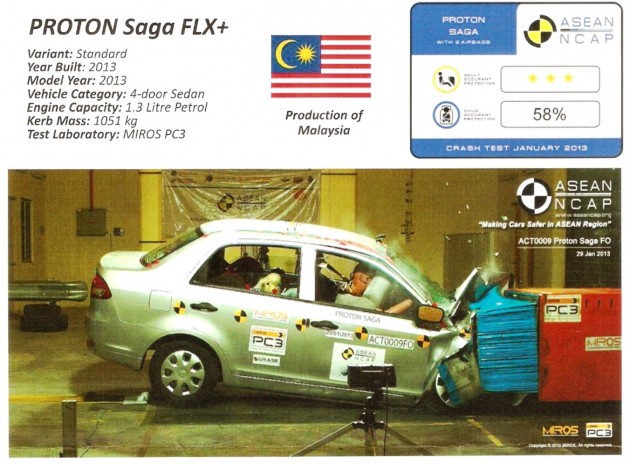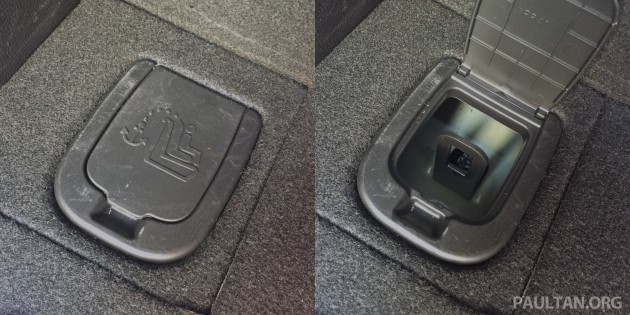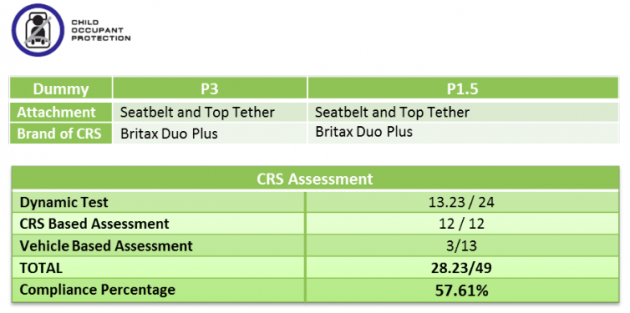Proton has released a new statement regarding the so-called ASEAN NCAP tether-gate, where the Malaysian carmaker has now admitted to “mistakenly omitting” the top tethers from the current Saga models. The company regrets the miscommunication with ASEAN NCAP on the matter.
The statement further clarifies that the top tethers were among more than 10 safety enhancements that were added to the Saga in order to obtain a three-star rating. These include a front bumper beam, additional reinforcement to the front and rear bumpers, front doors, centre pillars and rear seat back support, the addition of a front passenger airbag, front seat belt pre-tensioners and a rear centre three-point seat belt.
A quick recap – the Saga was initially given a one-star rating in 2012, and was subsequently crash tested again in 2013, this time fitted with the enhanced safety package detailed above. The improved Proton Saga received a three-star rating, which has stayed in place until now.
As for the removal of the top tethers on current Saga models, the Proton statement explained that, “the top tether was not a regulatory requirement for OEMs to fit in their cars at the point when the car was tested. Although we had complied with safety regulations and other required conditions in the country, we had overlooked in updating ASEAN NCAP on the omission of the top tether from the current Saga models.”
The carmaker also pointed out that, “the top tether (or the lack of) does not in any way affect the safety of Adult Occupancy Protection (AOP), as it is meant for the installation of child seats that are fitted with a top tether mechanism. In this case, child seats can still be fitted in the car through normal rear seat belt installation.”
As a solution, Proton is now offering current Saga owners free installations of top tethers. Customers are advised to call Proton Customer Care Hotline (1 800 88 8398) or email [email protected] to schedule an appointment to do so.
Basically, the issue here is that the Proton Saga was tested with top tether available, thus it was used in the installation of the Britax Duo Plus child seat utilised in the Child Occupant Protection part of the test. The child seat was secured to the car using the vehicle’s seatbelt and top tether. It scored 58% in this test.
Basically, since ASEAN NCAP now has no idea how the Proton Saga’s Child Occupant Protection would be like with the Britax Duo Plus secured with only the seat belts, the test results are deemed invalid. You can see the results with top tether in the table above.
The top tether is used as an additional anchorage point that limits the rotation of the seat in the case of a frontal impact. If you are using a child seat that doesn’t have a top tether anchorage in the first place, this doesn’t affect you.
There are benefits to having some kind of additional anchorage like a top tether available, as it can improve crash performance. An alternative to top tether is a support leg, which is far more common in Malaysia compared to top tether. If you cannot find a child seat with top tether which suits you, or if your car doesn’t have a top tether point, look for a child seat with a support leg. A support leg doesn’t require any point on the vehicle to attach to. Instead, it rests against the floor.
However, this requires the floor it is resting on to be solid. For example, the middle second row seat of the Volkswagen Sharan has an underfloor storage area below it, and requires an accessory to be installed in the storage box for a child seat with a support leg to be used on that seat. So please check your car’s manual to be sure.
More recently, ASEAN NCAP itself used a newer R129 i-size type of child seat (Takata i-size Midi ISOFIX) with its latest crash test of the Toyota Hilux. That particular child seat uses a support leg instead of top tether.
AD: Drive the Proton model of your dreams. Submit your details and Proton PJ will get in touch with you.
Looking to sell your car? Sell it with Carro.
























AI-generated Summary ✨
Comments reflect disappointment and outrage over Proton's omission of the top tether in their vehicles, viewed as a serious safety lapse and a breach of integrity. Many believe Proton deliberately removed the feature to cut costs, undermining safety standards and losing consumer trust. There’s a consensus that Proton’s admission is a step forward, but skepticism remains about their honesty and quality, especially given past scandals and poor safety ratings. Some highlight that many owners do not even use the top tether, questioning its impact, yet emphasize that safety features should not be compromised. Overall, sentiments are strongly negative, criticizing Proton’s integrity, management, and the potential danger posed to children and families, with calls for accountability and better industry regulation.